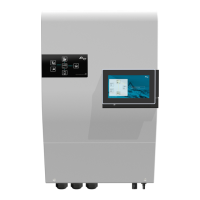Studer Innotec SA
next3
106 V 1.3 © Studer-Innotec SA next3 Tech manual
In a general manner, lead batteries charging profile consist of 3 to 4 phases while the lithium
only need 2; bulk and floating.
When connected to a communicating lithium battery BMS, the charging profile is given by
the BMS and cannot be adjusted in the next settings.
For more information, contact your battery supplier who will inform you on the values to be
applied for his products.
Caution: the equalization of open liquid electrolyte batteries (vented) produces
highly explosive and corrosive gas (hydrogen/oxygen). The battery room and/or
compartment must be adequately ventilated.
Be careful: this charging phase may bring the batteries to voltage levels that can
damage sensitive loads connected to the battery DC bus. Check that the
connected loads are compatible with the highest voltage levels possible taking
into account any compensation of the temperature sensor.
A too long or frequent equalization phase can lead to an excessive consumption
of electrolyte, a premature ageing or destruction of the battery. Follow
scrupulously the instructions and recommendations of your battery supplier.
8.5.4.2 Temperature compensation
For non-communicating battery (no BMS) with a nx-tempSensor, the voltage adjustment
levels for charging the battery (absorption, equalization, floating…) are automatically
corrected in real time according to the battery temperature.
The value of this compensation is given in V/°C for a reference temperature of 25°C by a
parameter. Default value corresponds to -3mV/°C/cell which is -0.072V/°C for a 48V battery.
For example at a temperature of 30°C, the voltage compensation is: (30-25)*(-0.072) = -0.36V.
For a floating voltage value set to 54.4V, the effective floating voltage (compensated) will
be 54.04V at 30°C.
Another example with 5°C, the compensation will be (5-25)*(-0.072) = +1.44V, so a floating
voltage that goes from 54.4V to 55.84V.
Caution: incorrect values which do not comply with the manufacturer's
instructions can lead to a premature ageing and even the destruction of the
batteries.

